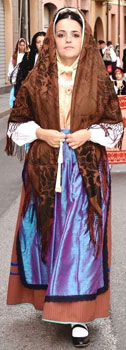Since 2002, the Folk Group Pro Loco Uta has started a work of reorganization and research in order to restore the traditional dress of the town. They eliminated every frivolous and useless transformation done , without well-grounded and reliable researches, by private citizens that have twisted the essence and the beauty of the traditional dress of Uta.
Goffredo Casalis, in 1838, described as follows the traditional dress of Uta in his “Dizionario Storico e Statistico del Regno di Sardegna”:
ORIGINAL TEXT
“La moda del vestire è pure poco dissimile; camicie a basso collo e maniche gonfie, calze larghe di lino, brache di panno nero, rustico (forese), corte e larghe, e usati dello stesso; farsetto azzurro-carico con bottoncini d’argento; giacchetta o giubbettino del suddetto forese, con rivolte di velluto azzurro, berretto nero e cappello a falde larghe coperto di tela cerata nell’estate, lo lasciano quando indossano, come soglion d’inverno, il cappotto o la gabbanella, che serve nel maggior freddo, perché il capo rivestesi allora del cappuccio. Tutti portano o la pertica o i bastone, quella formata d’un virgulto ben diritto e bianco d’olivastro, questa di cuor d’elce lavorato in otto facce, ben levigato e lucente; una ed altro di tale altezza, che sul suo capo tenuto ad ambe mani vi possano, senza troppa inclinazione, posare il mento, come fanno, quando son composti a grande attenzione, o sono occupati di qualche considerazione. Le donne portano ne’ giorni ordinari d’opera il color cremisi nella gonnella del panno suddetto, nei dì festivi lo scarlatto, o l’indiana, camicia di mussola, chiusa sul petto con due bottoni d’oro, busto di persiana in oro, o stoffa di seta, cuffia di seta rossa e fazzoletto bianco ricamato per velo.”
So the dress has been reconstructed following its evolution between the first half of 1800 and the beginning of the last century .
The dresses worn today by the women of the folk group Pro Loco Uta belonged to different ages and to women of different walk of life, while those of the men have been made following the information contained in the previously mentioned Casalis’ work and the evolutions that it has undergone during the beginning of 1900.


